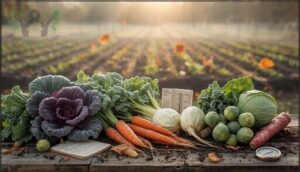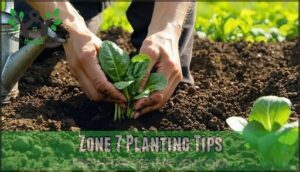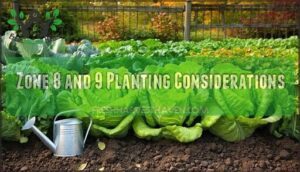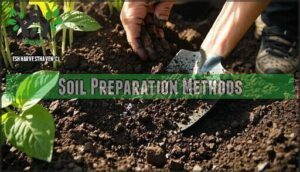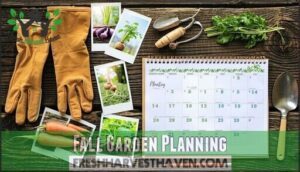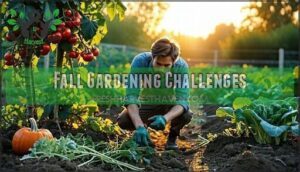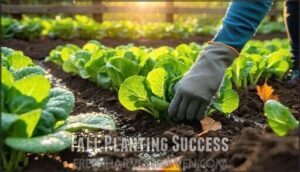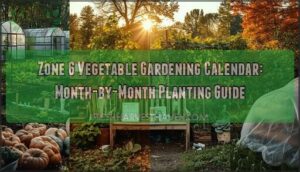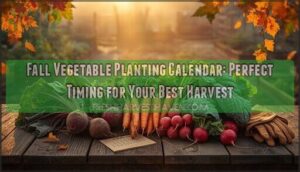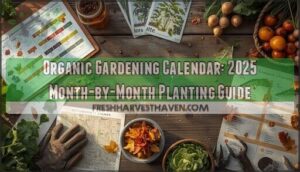This site is supported by our readers. We may earn a commission, at no cost to you, if you purchase through links.
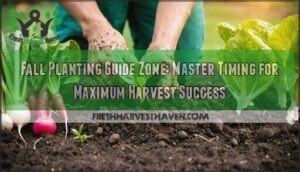
Count backward from your area’s first frost date using seed packet maturity information—Zone 6 gardeners plant 45-day crops by early October for November harvests, while Zone 8 has until late October.
Cold-tolerant vegetables like lettuce, spinach, and radishes thrive in cooler temperatures, often tasting sweeter after light frost.
Success hinges on understanding your specific zone’s frost patterns and choosing appropriate varieties.
Smart gardeners know that fall’s shorter days mean slower growth, so you’ll need to adjust expectations accordingly.
The real game-changer lies in mastering soil preparation techniques that most gardeners completely overlook, which requires understanding of your specific zone’s conditions and the importance of fall planting to achieve the best results with cold-tolerant vegetables.
Table Of Contents
- Key Takeaways
- Fall Planting Basics
- Choosing Fall Crops
- Zone-Specific Planting
- Planting Techniques Tips
- Fall Garden Planning
- Fall Gardening Challenges
- Fall Planting Success
- Frequently Asked Questions (FAQs)
- When should I start planting my fall garden?
- When to plant a fall garden in zone 7?
- What can you plant now for fall?
- When to plant a fall garden in zone 8?
- When should I start my fall garden?
- What can I plant right now for fall?
- When to plant fall crops in zone 7?
- What is considered early fall for planting?
- How to winterize perennials in fall?
- Can I overwinter certain vegetables outdoors?
- Conclusion
Key Takeaways
- Time your planting by counting backward from your first frost date using seed packet maturity information—Zone 6 gardeners need to plant 45-day crops by early October, while Zone 8 has until late October.
- Focus on cold-tolerant vegetables like lettuce, spinach, kale, and radishes that actually taste sweeter after light frost and can handle temperature drops better than warm-season crops.
- Prepare your soil properly with organic matter, proper pH testing (6.0-7.0), and good drainage—this foundation determines whether your fall crops will thrive or struggle.
- Use season extension techniques like row covers, mulching, and cold frames to protect plants from unexpected frosts and extend your harvest window by 8-10 weeks beyond typical frost dates.
Fall Planting Basics
You’ll discover that fall planting isn’t just about throwing seeds in the ground when temperatures drop.
The secret to a thriving autumn garden lies in understanding your specific planting zone and timing your crops perfectly with nature’s cooling rhythm.
Planting Calendar Importance
When you’re planning your fall garden, timing isn’t just important—it’s everything.
Your fall planting guide and zone planting calendar become your roadmap to success, helping you nail the best timing for each crop.
Understanding frost dates and regional variations helps you confirm you’re not planting lettuce when winter’s knocking.
Smart fall garden planning incorporates succession planting and crop rotation, maximizing your autumn planting schedule for continuous harvests.
Regional Climate Considerations
Your gardening zone guide isn’t the whole story—microclimate impacts can shift your planting window by weeks.
Frost pockets form in low-lying areas, while south-facing slopes stay warmer longer.
Check local weather patterns and regional variations beyond your zone planting calendar. A planting zones map shows averages, but your backyard’s unique conditions matter more for zone-specific planting success.
Benefits of Fall Gardening
You’ll discover fall gardening tips that transform your growing season into an extended harvest goldmine.
Cooler weather means less watering and reduced pests naturally protect your cool season crops.
Your soil health improves as organic matter decomposes, creating perfect conditions for a thriving fall garden guide success story.
Choosing Fall Crops
Selecting the right crops for your fall garden can make the difference between a thriving harvest and disappointment when frost arrives.
You’ll want to focus on vegetables that actually prefer cooler weather and can handle temperature drops, while also considering how quickly they’ll mature before winter sets in.
Cold-Tolerant Vegetables
You’ll want to focus on fall vegetables that laugh at cold weather.
Kale, Brussels sprouts, and Swiss chard actually taste sweeter after frost hits.
Check your zone’s vegetable planting chart for timing – these cool season crops handle temperatures down to 20°F.
Cabbage and collards are champions for overwintering crops, while spinach thrives in most hardiness zones with minimal frost protection needed.
Consider investing in cold weather gardening supplies for best results.
Quick-Maturing Crops
Beyond cold-hardy staples, you’ll want Fast Harvest crops that mature quickly before winter arrives.
Radishes, lettuce, and spinach reach harvest in 30-45 days, perfect for Succession Planting every two weeks.
Your vegetable planting chart should prioritize Fall Varieties like arugula and Asian greens.
These zone-appropriate choices maximize your fall planting window through strategic Indoor Starts and smart Crop Rotation.
Root Crops for Fall
Root vegetables thrive in fall’s cooler weather, developing sweeter flavors as temperatures drop.
These hardy crops handle frost better than leafy greens, making them perfect for extending your harvest season.
Here are five top root crops for fall planting:
- Carrot Varieties – Plant ‘Nantes’ or ‘Chantenay’ types 10-12 weeks before hard frost for crisp, sweet roots
- Radish Growing – Quick 30-day crops like ‘Cherry Belle’ provide fast satisfaction and soil-breaking benefits
- Turnip Benefits – Dual-purpose vegetables offering both tender greens and flavorful roots in 50-60 days
- Beet Cultivation – Cold-hardy ‘Detroit Dark Red’ varieties sweeten after light frosts, ready in 55 days
- Parsnip Care – Long-season crops requiring 120 days but delivering incredibly sweet, nutty flavors after frost exposure
These fall garden vegetables actually improve in taste when exposed to cool weather, as starches convert to sugars.
Zone-Specific Planting
Your plant hardiness zone determines when you can safely start fall crops without risking early frost damage.
Each zone has specific planting windows that maximize your harvest before winter arrives, so knowing your zone’s timing can mean the difference between a thriving fall garden and disappointed hopes.
Zone 6 Planting Guidelines
Zone 6 gardeners face unique challenges with winter temperatures dropping to -10°F.
Your first frost dates typically fall between October 10-20, making timing critical for fall planting guide success.
Plant cold-hardy vegetables like kale and spinach by September 1-15.
Consider purchasing suitable hardy vegetables for best results.
Monitor soil temperature—it stays favorable above 50°F until early October.
Zone 6 microclimates can vary substantially, so consider your specific location’s crop hardiness requirements and winter protection needs.
Zone 7 Planting Tips
Your fall garden checklist begins in late August for zone-specific planting in Zone 7.
Start planting vegetables fall crops like spinach and kale 6-8 weeks before your first frost date (October 15-November 15).
Soil amendments boost germination when temperatures stay above 45°F, consider microclimates and adjust watering needs accordingly for desirable results, including the use of soil amendments.
Zone 8 and 9 Planting Considerations
Warmer temperatures in these zones mean you can plant warm-climate crops like lettuce and Asian greens through October.
Your extended harvest window lasts until December’s first frost, but increased pest pressure from aphids and cabbage worms requires vigilant monitoring.
Soil temperatures stay favorable longer, though watering needs remain high through early fall.
Planting Techniques Tips
You’ll need proper soil preparation and smart watering techniques to make your fall garden thrive in your specific zone.
The right mulching strategy and early pest management will protect your crops from temperature swings and hungry critters looking for an easy meal, using smart techniques.
Soil Preparation Methods
You’ll transform ordinary dirt into a nutrient-rich foundation that’ll make your fall crops thrive.
Proper soil preparation sets the stage for gardening success, so don’t skip these essential steps:
- Test soil pH – Most vegetables prefer 6.0-7.0 range
- Add organic matter through composting methods like aged manure or leaf mold
- Improve drainage by incorporating coarse sand or perlite into heavy clay
- Till gently 6-8 inches deep for nutrient enrichment without damaging soil structure.
Clear your garden beds by removing weeds and debris to prevent future problems.
Watering and Mulching Strategies
After preparing your soil, proper watering frequency becomes your garden’s lifeline.
Water deeply but less often to encourage strong root development in cooler temperatures.
Apply organic mulch types like shredded leaves or straw around plants for moisture retention and winter protection.
Consider using specialized fall mulch for added benefits.
This combination maintains ideal soil temperature while reducing watering needs as your fall planting guide recommends for zone-specific gardening success.
Pest and Disease Management
Proper watering and mulching create ideal conditions, but you’ll still need to tackle pests and diseases that threaten your fall garden.
Smart pest identification and disease prevention strategies protect your harvest when temperatures drop and humidity rises.
- Beneficial Insects: Attract ladybugs and lacewings with diverse plantings to control aphids naturally
- Crop Rotation: Move plant families to different beds, breaking pest cycles and reducing soil-borne diseases
- Organic Solutions: Use neem oil sprays and diatomaceous earth for chemical-free pest control
- Disease Prevention: Make certain of proper spacing and air circulation to minimize fungal issues in cool, damp conditions
Fall Garden Planning
Creating your fall garden schedule doesn’t have to feel like solving a puzzle with missing pieces.
Start by working backwards from your first expected frost date, then use seed packet information to map out when each crop needs to go in the ground for a successful harvest.
Creating a Planting Schedule
Your fall planting schedule becomes your garden’s roadmap to success.
Start by mapping your zone-specific planting dates, then build in schedule flexibility for weather surprises.
Plan succession planting every two weeks for continuous harvests.
Factor in microclimate adjustments around your yard’s unique spots.
Include companion planting partnerships and maintain detailed record keeping for future seasons.
Using Seed Packets for Planning
Seed packets contain everything you need for successful fall planting guide timing.
Check packet information for germination rates and planting depth requirements specific to your zone.
Seed viability dates guarantee fresh starts, while spacing needs prevent overcrowding.
Understanding the need for proper air circulation is also key to preventing overcrowding.
Use these details to calculate backwards from your first frost date, creating a foolproof seasonal planting schedule that maximizes your harvest window with proper planning.
Extending The Growing Season
Something special happens when you combine season extension methods with smart timing—your harvest window stretches well beyond typical frost dates.
Cold frame gardening and row cover use can extend growing by 8-10 weeks, while greenhouse benefits include year-round production.
Overwintering techniques like deep mulching protect root crops through winter. These zone-specific planting strategies transform your fall planting guide.
Fall Gardening Challenges
Fall gardening brings unique obstacles that can catch even experienced gardeners off guard, from unexpected frosts that threaten tender seedlings to persistent weeds that seem to thrive in cooler weather.
You’ll need strategic planning to tackle these seasonal challenges while keeping pests and diseases from derailing your harvest goals.
Dealing With Frost
Protecting your fall planting from frost requires smart timing and preparation. You can’t control Mother Nature, but you can outsmart her with proper plant hardiness knowledge and microclimate management.
Essential frost protection methods include:
- Row covers – lightweight fabric shields that trap warm air
- Water walls – thermal mass that releases heat overnight
- Mulching – insulates soil and plant roots effectively
- Strategic placement – use walls and structures as windbreaks
Monitor weather forecasts for predicting frost warnings, especially during seasonal periods when temperatures fluctuate unpredictably.
Managing Weeds in Fall
Cooler temperatures don’t slow down persistent weeds in your fall gardening efforts.
Fall Weed ID becomes critical as winter annuals like chickweed emerge alongside summer stragglers.
Preventative Measures include thick mulching and proper spacing to crowd out competitors.
Organic Control methods like hand-pulling work best in moist fall soil.
Winter Weed Prep through regular cultivation maintains Soil Health while preventing spring weed explosions.
For ideal results, consider pre-emergent herbicide application when soil temperatures are right.
Preventing Pests and Diseases
Fall temperatures create ideal conditions for many garden pests and diseases to thrive before winter.
Fall’s cooler weather brings both garden opportunities and pest challenges that require smart prevention strategies.
You’ll want to focus on prevention through Beneficial Insects, Companion Planting, and Crop Rotation strategies.
Choose Resistant Varieties when possible, and maintain excellent Soil Health for natural pest reduction.
These fall gardening tips will keep your seasonal planting tips effective throughout autumn.
Fall Planting Success
Your fall planting success depends on tracking your crops’ growth and staying flexible with your approach.
Monitor soil temperature, watch for signs of stress, and be ready to adjust watering or protection methods as weather changes throughout the season, which is crucial for overall success.
Monitoring Progress
After addressing common fall gardening challenges, tracking your plants’ development becomes your next priority.
Regular monitoring helps you catch issues early and guarantees timely harvest timing through these essential checkpoints:
- Growth Rate: Measure weekly progress against expected development milestones for your zone-specific planting schedule
- Soil Moisture: Check depth penetration weekly, adjusting irrigation based on weather impact and seasonal changes
- Pest Control: Inspect leaves and stems bi-weekly for early detection using your fall planting guide protocols
- Harvest Readiness: Test firmness, color, and size indicators following your fall gardening guide recommendations
To optimize your planting schedule, remember to count backward accordingly from the first frost date.
Adjusting Planting Strategies
When your fall planting guide by zone isn’t delivering expected results, it’s time to pivot like a seasoned quarterback.
Microclimate management becomes essential—maybe that sunny spot now needs afternoon shade protection.
Adjust your succession planting intervals if crops mature faster than anticipated.
Consider companion planting adjustments and soil amendments based on current performance.
Smart crop rotation tweaks can salvage challenging seasons.
Enjoying Fall Harvest
Your hard work pays off when you’re savoring crisp lettuce from your community gardens or sharing seasonal recipes featuring homegrown kale.
This fall season planting guide by zone helps you celebrate harvest time through preserving techniques, fall foraging adventures, and harvest celebrations with neighbors.
Each zone-specific planting effort transforms into delicious meals that showcase autumn’s bounty perfectly.
Frequently Asked Questions (FAQs)
When should I start planting my fall garden?
Picture crisp morning air kissing your cheeks as you survey potential planting spots.
Start your garden 10-12 weeks before your first expected frost date. Check your zone’s specific timing since you’ll need crops matured before winter frost hits.
When to plant a fall garden in zone 7?
In zone 7, you’ll want to start your fall garden 10-12 weeks before your first frost date, typically mid-July to early August for cool-season crops like lettuce and spinach.
What can you plant now for fall?
Don’t think it’s too late – August’s perfect for cool-season crops! Plant lettuce, spinach, radishes, and kale now. They’ll thrive in cooler fall temperatures and give you fresh harvests through autumn.
When to plant a fall garden in zone 8?
Plant your fall garden in zone 8 between mid-July and early September.
You’ll want to start cool-season crops like lettuce, spinach, and radishes about 10-12 weeks before your first expected frost date.
When should I start my fall garden?
Start your fall garden 10-12 weeks before your area’s first frost date. Count backwards from that date, then sow cool-season crops like lettuce, spinach, and radishes for perfect autumn harvests.
What can I plant right now for fall?
Looking at your specific location and timing, you can plant radishes, beets, turnips, carrots, lettuce, spinach, pak choi, and kale right now for fall harvest.
These cool-season crops thrive when temperatures drop and taste sweeter after frost.
When to plant fall crops in zone 7?
Mid-July to early August is your sweet spot for most fall crops.
Direct sow radishes, carrots, beets, turnips, and kale in late July through August.
You’ve got until mid-September for quick growers like spinach and lettuce, which can be considered quick growers.
What is considered early fall for planting?
Like clockwork, early fall typically begins in late August through early September, giving you the perfect window to establish cool-season crops before frost arrives in your area.
How to winterize perennials in fall?
Cut back perennials to 2-3 inches after first hard frost. Mulch around base with 3-4 inches of straw or leaves. Remove any diseased foliage completely to prevent spring problems.
Can I overwinter certain vegetables outdoors?
You can successfully overwinter cold-hardy vegetables like kale, spinach, Brussels sprouts, carrots, and leeks outdoors with minimal protection—they actually become sweeter after frosts.
Conclusion
Mastering your fall planting guide zone transforms autumn gardening from guesswork into guaranteed success.
You’ve learned timing calculations, cold-tolerant crop selection, and zone-specific strategies that guarantee productive harvests.
Your soil preparation techniques, frost management skills, and seasonal adjustments create the foundation for thriving fall gardens.
Remember, shorter daylight hours mean patience pays off—your carefully planned fall garden will reward you with fresh vegetables long after summer gardens fade.


